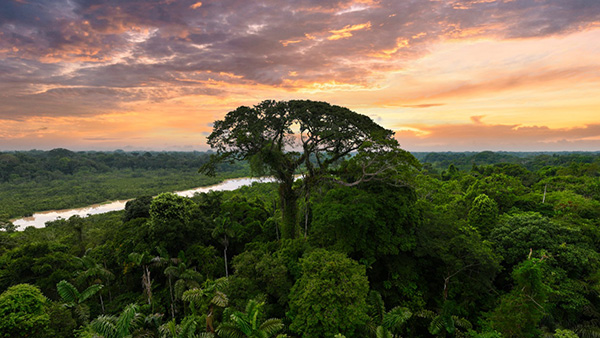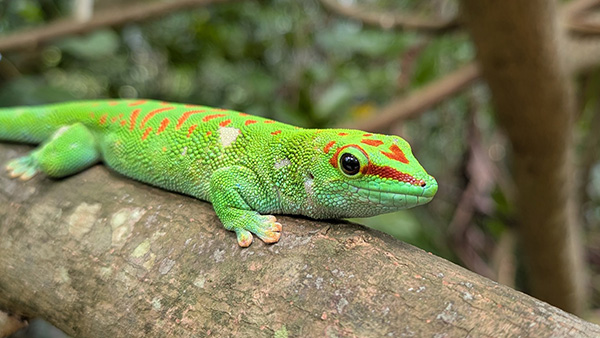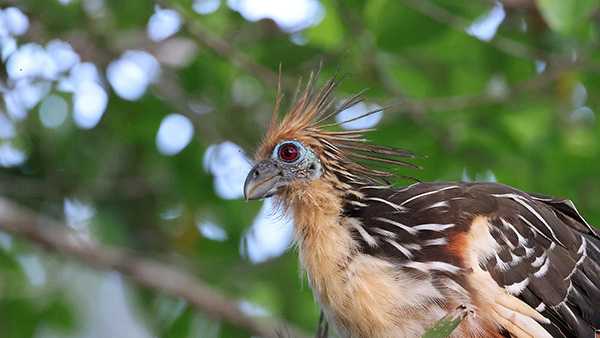WORLD RAINFOREST
By Rhett A. Butler Last updated Aug 14, 2020
The Tropical Rainforest - information on tropical forests, deforestation, and biodiversity
Sections:
The Latest News on Rainforests
Indonesia’s idle land problem (Aug 21 2025)
Founder’s Briefs: An occasional series where Mongabay founder Rhett Ayers Butler shares analysis, perspectives and story summaries. Indonesia is defying the global trend in tropical deforestation. While forest loss in much of the tropics reached record highs in 2024, Indonesia’s rate fell by 14% compared with the previous year. Yet beneath this apparent success lies […]
How rain can reveal what lives in rainforest treetops (Aug 20 2025)
How rain can reveal what lives in rainforest treetops Perched high above the forest floor, the tropical canopy is a reservoir of biodiversity that has long resisted scrutiny. Its inaccessibility has left many of its inhabitants — orchids, epiphytes, ants, monkeys, frogs — poorly studied and poorly protected. But a new study offers a workaround: […]
Pulp and paper giant APP moves closer to regaining FSC stamp despite pending review (Aug 20 2025)
- The Forest Stewardship Council has allowed Asia Pulp & Paper — “one of the world’s most destructive forestry companies” — to resume its remedy process toward regaining certification it lost in 2007 for deforestation and land conflicts.
- Watchdog groups say the decision is premature because a legal review of APP’s links to Paper Excellence/Domtar, the biggest pulp and paper company in North America, is still unfinished.
- Critics warn the move could erode trust, enable greenwashing, and expose communities in conflict with APP-linked companies to further harm.
- NGOs are calling for the remedy process to be paused until the review is completed and for full transparency on corporate ownership and compliance.
Venezuela tries an environmental rebrand, but critics aren’t buying it (Aug 19 2025)
- Venezuelan President Nicolás Maduro last month unveiled the Gran Misión Madre Tierra, or “Great Mother Earth Mission,” designed to address Venezuela’s climate emergency.
- The mission mandates the creation of new reforestation efforts, climate change adaptation and response programs, a national waste management initiative, and sustainable agricultural practices.
- But critics say the government’s renewed interest in environmental issues is a way to access climate financing and appease international partners.
- They say the mission strategically omits oil spills and illegal gold mining in protected areas — activities that government officials sometimes facilitate for personal benefit.
How Indonesian companies dodge fines for forest & peatland fires (Aug 19 2025)
- While Indonesia’s courts have fined plantation companies more than $21 trillion rupiah ($1.3 billion) for forest and peatland fires, almost none of that money has been collected.
- This fuels a cycle of impunity where fires continue to flare up in concessions already found guilty by court.
- In a common pattern, companies found guilty of burning forests either shield their assets, declare bankruptcy or exploit loopholes to avoid paying.
- Indonesia’s enforcement gaps also allow repeat offenders to continue operating unchecked, profiting from the very land they were banned from using.
World Orangutan Day: Ongoing threats & habitat loss haunt these great apes (Aug 19 2025)
Despite years of research into their complex behavior and intelligence, orangutans remain critically endangered on the islands of Borneo and Sumatra, where they’re endemic. Mongabay has extensively covered the threats they face from habitat degradation and what studies say about how human activities affect them. This World Orangutan Day, on Aug. 19, we take a […]
US proposes threatened listing for widely trafficked Borneo earless monitor (Aug 18 2025)
The U.S. Fish and Wildlife Service has recently proposed listing the Borneo earless monitor, an elusive lizard endemic to the Southeast Asian island of Borneo, as threatened under the Endangered Species Act. Borneo earless monitors (Lanthanotus borneensis) are illegally trafficked for the international pet trade. Finalizing the threatened listing would prohibit the import, export and […]
What’s at stake for the environment in Bolivia’s upcoming elections? (Aug 15 2025)
- Bolivians will go to the polls on Aug. 17 to vote for a new president, vice president and 166 combined members of the Senate and the Chamber of Deputies.
- Polls suggest that conservative candidates Jorge “Tuto” Quiroga and Samuel Doria Medina have the best chance of winning, with a focus on economic recovery rather than the environment.
- Their policies will determine the future of the lithium industry, illegal gold mining and forest loss in the Amazon and Chiquitania.
Will we still eat beef in 50 years? (Aug 15 2025)
- Beef production contributes to numerous global crises, from climate change to habitat destruction to biodiversity loss.
- Big conservation NGOs have worked fervently to combat these crises, and many also have programs to encourage more sustainable ranching practices.
- Proponents of “regenerative ranching” and similar approaches that involve rotational grazing and other strategies say these practices have benefits for preserving grassland habitats, encouraging the diversity of birds, wildlife and grasses that live on these ranches and sequestering carbon in their soils.
- But many conservationists also contend that the world must reduce the number of cattle on the planet and find other sources of protein.
Brazil’s Forestry Code seeks to strengthen forest conservation, but controversies remain (Aug 14 2025)
- Suffering repeated changes, Brazil’s Forest Code regulates protected areas and forest management on private property, as well as commercialization of forest products.
- If a landholder exceeds the legally permitted area eligible for conversion, they are legally required to restore the forest to meet the Code’s requirements.
- In 2012, the Forest Code was modified to lessen restoration requirements under certain circumstances and freed landholders of liability for any fines or damages linked to forest clearing prior to 2008.
NASA satellites show surge in Indonesia hotspots as 2025 fires send smoke to Malaysia (Aug 13 2025)
- NASA satellite data show a dramatic uptick in fire hotspots across Indonesia, with smoke from Sumatra detected in Malaysia in late July.
- The July spike follows early warning signs in May and June, with most fires detected in peatlands and fire-prone agricultural areas, raising alarms over worsening air quality, public health, and environmental damage.
- Activists warn the 2025 fire season could be one of the worst in recent memory, rivaling past disaster years.
- The crisis unfolds a decade after Indonesia’s 2015 fire disaster, which burned 2.6 million hectares, caused an estimated 100,000 premature deaths, and triggered a regional haze crisis affecting Singapore and Malaysia.
Unrestricted funding is key for frontline conservation groups: Mongabay podcast (Aug 12 2025)
The U.S.-based Wildlife Conservation Network (WCN) works to link funders with community-based conservation groups, ensuring that much-needed resources are reaching the frontlines. In a Mongabay Newscast episode in July, Jean-Gaël “JG” Collomb, CEO of WCN, advocates for giving more unrestricted funding to local groups who know the environment best, allowing them to decide how to […]
Borneo killing linked to coal industry stays unsolved as Indonesia VP visits Dayak village (Aug 12 2025)
- On Nov. 15, 2024, two Indigenous men were attacked before dawn at a checkpoint in Muara Kate, a roadside hamlet in East Kalimantan province, established by the local population to enforce a ban on mining vehicles using local roads. This community decision followed the death of a young pastor a month earlier in an accident with a coal truck.
- Police have questioned staff from coal miner PT Mantimin Coal Mining in connection with the case, but at the time of writing, authorities had yet to name any suspects in connection with the November murder.
- In June, Indonesia Vice President Gibran Rakabuming Raka visited the community where the killing took place; an aide to the vice president said a report would be made to President Prabowo Subianto.
- Killing of environmental defenders in Indonesia is rare compared with countries like Brazil and the Philippines, but political scientists say democratic conditions in Indonesia have been eroded in the past decade.
The case for hope in environmental journalism (Aug 11 2025)
I often return to this image, which I took in 2022 in Jambi, Indonesia. At first glance, it seems to capture something hopeful: a full-circle rainbow arcing over a lush green landscape. But look closer, and you’ll see what lies beneath the beauty: a vast oil palm plantation, carved out of what was once native […]
Indigenous alliance unveils Brazil’s first Native-led emissions strategy (Aug 9 2025)
Brazil’s largest Indigenous organization has launched the country’s first Native-led strategy to cut greenhouse gas emissions, ahead of International Day of the World’s Indigenous Peoples on Aug. 9. The idea is for the plan to be incorporated into the Brazilian government’s own emissions reduction plan, the Nationally Determined Contribution (NDC), which the country updates and […]
Who is clearing Indonesia’s forests — and why? (Aug 8 2025)
- Most tropical countries are experiencing record-high deforestation rates, but in Indonesia, forest loss is slowing.
- But nearly half of the forest cleared in 2024 can’t be linked to an identifiable driver, raising red flags about speculative land clearing, regulatory blind spots and delayed environmental harm.
- Land is often cleared but not immediately used; research shows that nearly half of deforested lands in Indonesia remain idle for more than five years.
- Experts say these trends signal regulatory failure, as the government issues permits widely and concession holders face few consequences for clearing forest and abandoning the land, creating a cycle of destruction without accountability.
Formalizing small-scale gold mining can reduce environmental impacts & crime (commentary) (Aug 7 2025)
- Small-scale gold mining provides more jobs than any other mining sector, yet it’s also the world’s largest source of mercury pollution, a major driver of tropical deforestation, and its informal nature breeds organized crime and corruption.
- One proposed solution to these ills is investment in centralized gold processing plants — which are already operating in nations like Peru and Tanzania — because they use less toxic techniques to extract the ore, while reducing the prevalence of criminal networks in the industry.
- The next international climate summit, COP30, which will be hosted in Brazil’s Amazon, offers a strategic opportunity to put the gold mining issue squarely on the international agenda, a new op-ed argues: “Gold’s glitter will not fade, but if mined without reform, it will continue costing the world its forests, its rivers, and its security.”
- This article is a commentary. The views expressed are those of the author, not necessarily of Mongabay.
How urban greening is helping Singapore bounce back from widespread forest loss (Aug 7 2025)
Singapore, the smallest country in Southeast Asia, lost most of its original forest cover in the early 1800s to agriculture. But since the 1960s, when Singapore began pursuing urban greening initiatives, Singapore has greened 47% of its spaces, according to an episode of Mongabay’s podcast published in July. Speaking with host Mike DiGirolamo, Anuj Jain, […]
Lúcio Flávio Pinto: The Brazilian reporter who wouldn’t be bought or silenced (Aug 6 2025)
- For nearly six decades, Lúcio Flávio Pinto has reported fearlessly from the Brazilian Amazon, chronicling land grabs, illegal logging, and environmental destruction while refusing to be silenced or swayed by power or money.
- After leaving Pará’s dominant newspaper in 1987, he launched Jornal Pessoal, a fiercely independent, ad-free newsletter funded solely by subscriptions, modeled after I.F. Stone’s Weekly.
- Pinto has faced physical assaults, death threats, 33 lawsuits, and judicial harassment—including a criminal conviction—yet has remained rooted in Belém, documenting the Amazon’s unraveling when others fled or fell silent.
- Now in his seventies, Pinto’s memoir Como me tornei um amazônida reflects a life devoted not to advocacy, but to truth as a form of reverence—undaunted by the odds, still trying to write a different ending for the forest he loves.
Invasion intensifies on Karipuna Indigenous land in the Brazilian Amazon (Aug 6 2025)
Illegal invasions in the Karipuna Indigenous Territory in the northwest of the Brazilian Amazon have started to advance again, Karipuna leaders told Mongabay following an alert by global nonprofit Survival International. “This year has been very difficult because there are a lot of people on our territory,” André Karipuna, the chief of the Karipuna people, […]
Cocoa boom fuels new wave of deforestation in Cameroon (Aug 4 2025)
Once threatened by palm oil and loggers, Cameroon’s forests now face a new driver of deforestation: booming cacao production to supply the European market. A new report by the environmental advocacy group Mighty Earth finds deforestation in Cameroon has accelerated, with the country losing around 782,000 hectares (1.9 million acres), or 4.2% of its forest […]
Indonesian farmers plant hope for isolated Javan gibbons (Aug 1 2025)
In Indonesia’s Central Java province, two groups of Javan gibbons have become isolated in two small forest patches. To help the gibbons make their way to larger forest areas, a local NGO, SwaraOwa, is working with farmers in the region to restore and build “corridors” that would connect the fragmented forest blocks, Mongabay reported in […]
Uncovering forest loss in gorilla park six months after M23 offensive in the DRC (Jul 31 2025)
- Six months since M23 armed rebels took control of provincial capitals in the eastern Democratic Republic of Congo, local activists and satellite imagery collected by Mongabay have identified sites of expanding forest loss in Kahuzi-Biega National Park.
- Researchers say this is due to collapsing conservation efforts, lack of park monitoring, and massive logging and charcoal production inside the national park. While M23 and other militias don’t produce the charcoal directly, they profit by taxing its transport and trade.
- Activists who have denounced the illegal exploitation have been harassed, attacked, or even killed. Some, like Josue Aruna, have been forced into hiding or exile after facing death threats.
- On July 19, the DRC government and M23 signed a ceasefire agreement, with conservationists saying they hope this will create conditions for restoring security in the area and halt the destruction of the rainforest.
Indigenous leadership and science revive Panama’s degraded lands (Jul 31 2025)
Two Indigenous groups in Panama are collaborating with researchers in a long-term reforestation project that promises them income in return for growing native trees for carbon sequestration, Mongabay contributor Marlowe Starling reported in May. As part of the project, researchers from the Smithsonian Tropical Research Institute (STRI) have partnered with the local leadership in the […]
Arboreal camera traps reveal wildlife feasting on Borneo’s fruiting fig trees (Jul 31 2025)
Camera traps installed high in the rainforest canopy in Malaysian Borneo have filmed a bounty of threatened primates, hornbills and a host of tree-dwelling animals feasting on figs. Biologists from Malaysia-based nonprofit 1StopBorneo Wildlife, along with Sabah Parks and local conservationists, scaled two enormous fig trees in Tawau Hills National Park in Sabah state to […]

































